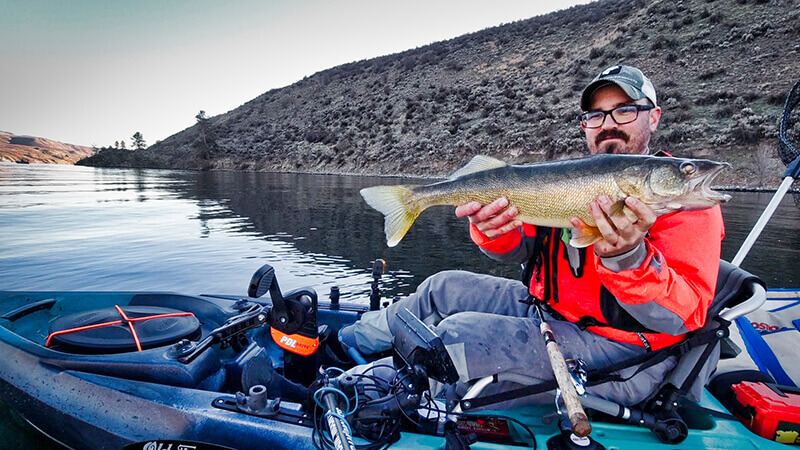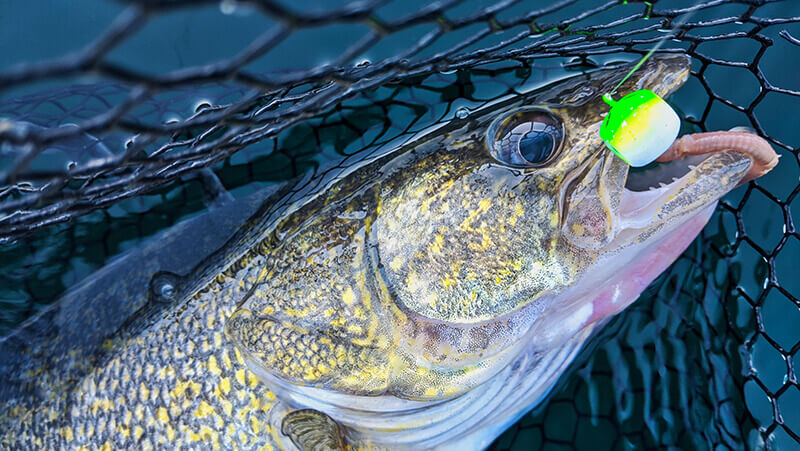Targeting Walleye From A Fishing Kayak
By: Tyler Hicks
JIGGING AND BLADE BAITING FOR BIG RIVER WALLEYE
In the not too distant future the Columbia River is likely to produce a world record Walleye. Few states have produced Walleye in excess of 20 lbs but with the big river consistently kicking out fish in the high teens each spring the odds of connecting with a fish of a lifetime are better than anywhere else. This potential is what draws die hard Walleye anglers from across the country to the Pacific Northwest. Walleye are distributed along the entire river and its impoundment from Canada all the way down to the city of Portland, Oregon. As a result whether you are looking to catch a trophy fish or just fill your freezer with delicious fillets then you’ll likely be fishing on the Columbia as it treks across Washington and Oregon on its way to the Pacific Ocean.
I grew up fishing Walleye in the Midwest and much of what I learned about fishing for Walleye in shallow often mud-stained lakes had to be thrown out the window when I moved to Washington. It took several seasons to dial in Walleye on the deep, cold, clear, and moving waters of the Columbia River. Pacific Northwest Walleye can be found at depths up to 150’ deep but more often occupy depths ranging from 20-50’ depending on the season and current.

Trolling is effective but for kayak anglers trolling downstream in current translates to long laborious battles upstream against current to repeat short trolls over productive fishing grounds. As a result I’ve quickly come to favor jigging for these fish that allows for more fishing time over the target area. Learning where Walleye are holding is key and some of the characteristics I look for are: current breaks or seams, transition zones between cobble and sand, and bottom structure such as mounds or reefs. Depth will vary greatly but I’ve found that as current speed increases fish tend to move shallower and deeper as current reduces. In general I look for natural drift speeds of 1.0 to 1.5 mph as indications of where fish are likely to be holding. Adding to this challenge is that Columbia River Walleye will often hold so tightly to the bottom they will rarely appear on sonar. However, having a fishfinder with down imaging and GPS helps to identify depth, bottom structure, and to mark locations where you are catching fish. I rely heavily on my Humminbird Helix 5 during my Walleye kayak fishing outings.
Due to the subtle bite of these Walleye and the depths at which you may be fishing it is easy to miss a strike. The right tackle can make a huge difference in angler success. I recommend a medium or medium-light graphite spinning rod spooled with a 10 or 15 lb braid. Due to the clarity of the water you’ll need a 3-5’ leader of 8 or 10 lb fluorocarbon tied in using a uni-uni knot. Critical to detecting the bite is a vertical presentation, you want your line straight up and down. Matching the drift of the current with the minimum of line out helps to transmit the bite information to the angler. If you feel anything that feels different from the bottom SET THE HOOK. Remember hook sets are free. The instant hands free reverse and forward on my PDL drives makes matching the drift easy and allows me to focus on fishing. Although I admit I am keen to put the Sportsman Autopilot and 106 Powered by Minn Kota models to use in these fisheries.

For lures and bait I keep it simple. I usually carry an assortment of lead head jigs with fine wire hooks ranging from 3/8 oz up to ¾ oz. If you have trouble feeling the bottom or keeping your line vertical simply step up the weight of jig you are using. Colors that I favor include chartreuse, black, white, or even unpainted do well. There many manufacturers of quality jigs including Northland Tackle, Walleye Nations Creations, VMC, and Kit’s Tackle. As for bait I generally favor a plain nightcrawler during the colder fall thru spring months but have done well with curly tailed grubs or Berkley Gulp plastics during the summer months. To fish these I drop them to the bottom and simply lift and lower the rod tip a few inches and tap them along the bottom as I drift.
Another lure I enjoy great success on is a blade bait. These are essentially a weighted vibrating spoon that are similar in profile to a lipless crankbait. Like a jig I drop them to the bottom and then rip upward 8-12”. As you rip upward you will feel the lure vibrate. Ninety-nine percent of all the bites will occur on the fall and when you go to rip the blade bait again you will feel the pressure or the bite of the fish. I generally fish ½ to ¾ oz blade baits in gold, silver, or painted in many of the same colors I use on jig heads.
Walleye can be incredibly frustrating at times and I know of few fisheries with such a challenging learning curve. Rivers are dynamic places to fish and the Walleye that occupy them can be unpredictable. Nothing can replace time on the water for helping you to learn but applying the above will certainly help set you on the path to harvesting your own Columbia River gold on your next kayak fishing outing.
Be sure to subscribe to Tyler's YouTube channel for more useful kayak fishing content.
